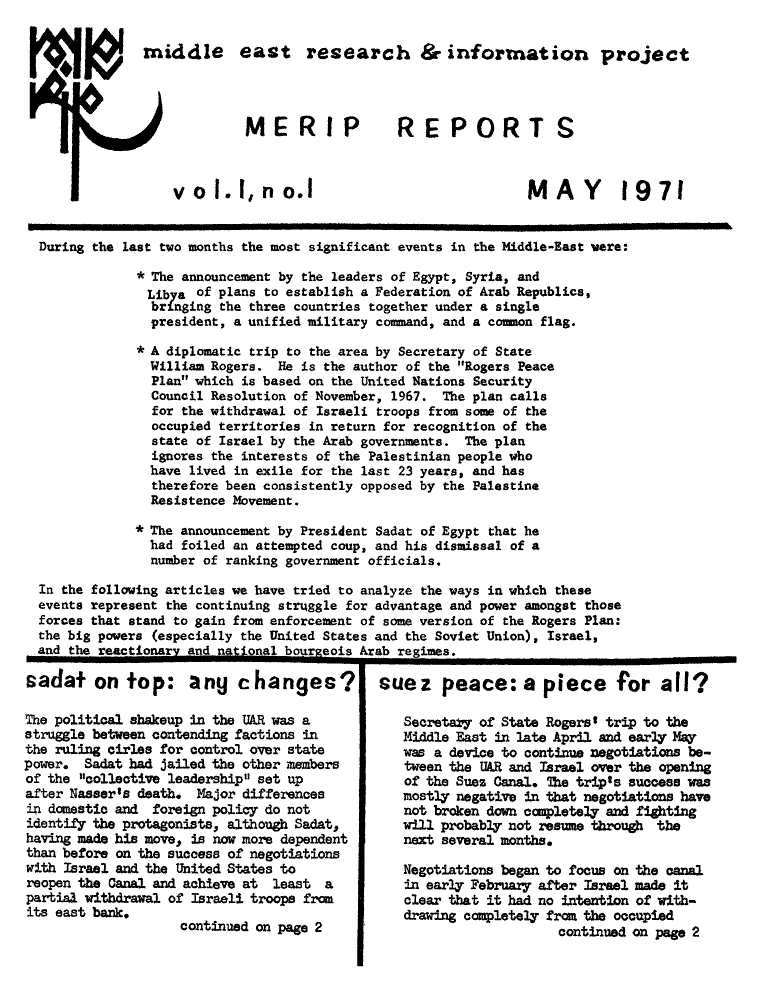At first, using the Gutenberg-like tools of yesteryear (Selectric typewriters, mimeograph machines) we envisioned the publication as a newsletter-commentary in the style of I.F. Stone’s Weekly, to serve the “New Left” that we saw ourselves as part of and whose critiques of imperialism largely avoided US policies in the Middle East and the “too complicated” Israel-Palestine conflict. Our name was quite intentional: We wore our Palestine solidarity on our sleeves, but this project was about research and information, about facts and analysis. Our working proposition was that understanding the Israel-Palestine conflict required understanding the political dynamics of the region, and that we would contest the prevailing “pro-Arab/pro-Israel” binary by critically assessing existing political regimes without exception.
We soon realized we would have to generate research and not simply convey information provided by others. This task meant, for some of us, making MERIP our day jobs (with frequent recourse to unemployment benefits). It also meant tapping into the work of the many graduate students among our early readers, who saw MERIP as an outlet for their own work. For many years cogent, politically progressive analysis of the region was unique to MERIP, something not found in progressive journals like The Nation or specialty publications like Middle East Journal, a situation that has changed in part thanks to MERIP’s pioneering efforts.
At its inception MERIP presented itself as a collective—two small clusters of named people in Boston and Washington, DC. By around 1980 or so we had assumed a more conventional organizational structure (editor, publisher, circulation manager, etc). None of the staff were academics or on academic tracks. We saw ourselves as outside the academy but, of course, wanted academics to take MERIP seriously. “Research and information about the role of the US in the Middle East, revolutionary struggles there, and the Palestine problem,” was how we presented ourselves. We would be topical “and try to respond to questions in the movement.” Over the first three to four years some folks dropped off, others came on. Judith Tucker was one of our first recruits from the universe of scholars and teachers who in years to come would be the mainstay of the organization though its editorial committee and network of contributing editors. We early on dropped the guise of anonymity and gave authors bylines.
MERIP Reports from its early years presented “alternative” country studies, with catchy (non-alternative and totally not original) titles like “Iraq and the Baath Party.” They were footnoted, and the footnotes reflected the literature available at the time. The spin was different but grounded. MERIP’s first Further Reading column in 1974 was, looking back at it today, embarrassing for its near-total reliance on works and authors we were striving to supplant. But then again, that’s why we started MERIP—there was a dire need for alternatives. In 1975 we produced the first of what would come to be several issues taking apart “the Middle East Studies Network” as a product of and handmaid to the US hegemonic project.
One consistent feature of MERIP’s output was its topicality and timeliness. The issues were thematic and many anticipated major eruptions—the outbreak of Lebanon’s civil war, the Palestinian Intifada and Iran’s revolution, for example. This approach was relevant to our outreach to left activists but also to classroom use. MERIP also grappled with Zionism, anti-Semitism and racism directed at Arab and other Middle Eastern communities in the United States. MERIP provided a grounded critique of US military and other interventions in the region—from rapid deployment to massive deployment, as one headline put it. One of the main reasons we started MERIP was to change US policy but, unfortunately, those changes went in very much the wrong direction.
From the outset MERIP paid attention to class formation and transformation and to workers—Arab workers in Detroit and Lackawanna, women textile workers in Egypt, workers’ councils in Iran. I see a high degree of synergy with academic cohorts in the attention we gave to issues of class and workers: Our coverage brought us audiences among left scholars, and some of those same scholars became the MERIP authors who contributed deeply informed discussions about workers in, for example, Egypt, Israel, Palestine, Algeria and Iran. Authors like Joel Beinin and Zachary Lockman did not direct their academic inquiries to workers and class because they had been turned on by MERIP. They were already well along in this work, but MERIP provided a forum in which they could preview their work and make it accessible to people outside the university and to undergraduate students.
Several colleagues speaking at the Middle East Studies Association (MESA) roundtable about MERIP in 2020 noted that MERIP’s contribution to Middle East studies was in its role as a venue for the work they wanted to do, as a source of information and timely coverage that Middle East studies was not providing and as a way to speak to readers outside of the academy. My perspective is that MERIP absolutely depended for its growth and impact on its dynamic relationship with scholars of the left—as contributors, as readers, as teachers who ordered MERIP issues for their classrooms. The audience MERIP originally envisioned for its work, left activists, lacked the coherence and the consistent interest in things Middle Eastern to sustain our project. MERIP’s relationship with Middle East studies was very much a two-way street. By serving as a vehicle for those scholars, MERIP served as a classroom asset.

